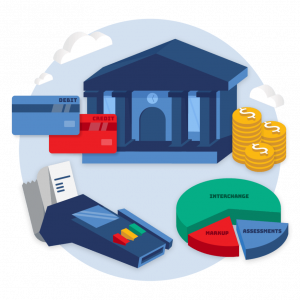Credit Card Processing: Pricing Structures
Explore Tiered, Flat Rate & Interchange Plus Pricing Models
When you accept credit card payments at your business, your payment processor will use one of a handful of common credit card pricing structures to shape your costs. Because these pricing models don’t all benefit small businesses in the same way, it pays to understand what they are, how they work, and how to compare them to each other.
We’ll discuss the three main types of credit card pricing structures below, including tiered pricing, flat rate pricing, and interchange plus pricing plans—along with their advantages and disadvantages.

Credit Card Pricing Models:
What You’ll Discover Below
Payment Processing 101
Understanding each type of credit card payment processing structure can help you decide which structure best suits your business.
Want to know more about payment processing as a business owner? Click the button below to access our paymentprocessing guide.
What are Credit Card Pricing Structures?
Credit card pricing structures are the methods payment processors use to organize credit card processing fees and charge merchants for their services (“merchant” just means a business that accepts credit card payments). Credit card pricing structures are also known as credit card pricing models and credit card pricing plans—terms we’ll use interchangeably below.
Pricing models are just the various ways payment processors cover their costs and make a profit off merchants. For the processors, these costs include:
- Interchange fees, which get set by the card networks like Visa and MasterCard, but which get paid to the banks that issued your customers’ credit or debit cards.
- Card brand fees that get paid to the card networks (Visa, MasterCard, Discover, and American Express).
These are the processor’s non-negotiable wholesale costs (the fees the processor has to pay), and every pricing structure is designed to make sure those costs get covered.
Beyond covering their wholesale costs, every processor tacks on fees of their own, called markups, to make money off their merchants. And that’s where credit card pricing structures or pricing models enter the picture.
Types of Credit Card Pricing Structures
There are three main types of credit card pricing structures to consider when shopping around for a payment processor: tiered pricing, flat rate pricing, and interchange plus pricing.
- Both tiered and flat rate pricing models are versions of so-called “bundle” pricing. They work to keep a merchant’s costs fairly simple and consistent month to month by categorizing transactions by type and setting different rates for each category.
- Interchange plus pricing is a bit more complex. It uses a pass-through approach to pricing merchants, which means you’ll pay the processor’s wholesale costs directly plus the processor’s markups on transactions and other processor service fees.
Which credit card pricing plan is best? That depends on your business’s sales and transaction volumes, your average ticket, and a host of other factors, but in the sections that follow we won’t make a secret of our preference for interchange plus pricing. Read on to discover why.
Interchange plus pricing structures are also known as “cost-plus” and “pass-through” pricing. This is because the pricing model works by passing through the payment processor’s wholesale costs (interchange fees and card brand fees) directly to the merchant. Then the processor tacks on its own markups and other service fees.
On the one hand, that means your costs will fluctuate each month based on the wholesale costs for the types of transactions you process, so you’ll pay more when a transaction’s interchange rates are higher. On the other hand, you’ll pay less when the interchange fees for a transaction are lower—which is why interchange plus pricing is often the cheapest pricing model for small businesses in the long run.
In our view, interchange plus pricing is the best pricing model for just about every merchant, large or small, which is why our payment processing service focuses almost exclusively on signing up merchants for interchange plus pricing plans.
Advantages of Interchange Plus Pricing
- Transparency. Interchange plus pricing is the closest thing to transparency you can find in the card payment industry. Because your merchant statements will distinguish between wholesale costs and your processor’s markups, it’s harder for a processor to tack on hidden fees, and you’ll generally have more insight into how your processing costs work.
- Savings. Interchange plus pricing isn’t always cheaper for every merchant, but because you’ll pay less for transactions with lower interchange fees, you’re in a position to track your costs and locate potential ways to save (such as instituting best practices for getting the lowest interchange rates you can).
Disadvantages of Interchange Plus Pricing
- Complexity. Because interchange plus pricing breaks monthly costs down into a wide range of fees (wholesale costs and processor fees), the resulting monthly statements often appear maze-like and can bewilder less experienced merchants. Still, dealing with that complexity is the only way available to truly understand the fees you’re paying.
Who Interchange Plus Pricing is Good For
Interchange plus pricing works best for small businesses with a fairly stable monthly income (so neither hobbyists nor occasional sellers) because the plans often involve monthly minimums and monthly fees. Your sales don’t necessarily need to be high, but you’ll need to process payments consistently each month to get the most out of an interchange plus pricing plan.
Interchange plus pricing is also only available for businesses that sign a merchant agreement with a processor that provides dedicated merchant accounts through an acquiring bank. This means you and your business will have to go through the processor’s underwriting process—including a credit check—before the processor will approve your account.
For most small businesses, that isn’t a problem, but if it will be for you, you might need to first work with a payment service provider that offers a flat rate plan and easier access to their services. That way, you can build a good processing history for your business and explore interchange plus pricing options down the road.
Tiered pricing models categorize transactions by type and apply different rates to each category (called tiers, buckets or bundles) shaped mainly by interchange rates. There are usually three rate tiers—qualified, mid-qualified and non-qualified—with progressively higher rates applied to each tier.
The details can vary from processor to processor, but generally transactions that meet certain standards—non-rewards cards, for instance, that are swiped or dipped—will be “qualified” at the lowest rates, while card-not-present (online and manually keyed-in) transactions, rewards cards, corporate cards, and so on will “downgrade” into one of the higher-priced tiers.
Advantages of Tiered Pricing
- Simplicity. You’ll always know every credit or debit card payment you accept will fall into one of your processor’s pricing tiers, so you can project your processing costs when you project your sales.
- Streamlined merchant statements. Since your transactions will be grouped in just a few tiers with corresponding rates, you won’t have a lot of line-items to look through on your merchant statements. (Which isn’t to say you’ll understand why you’re paying the fees you’ll pay.)
Disadvantages of Tiered Pricing
- Lack of transparency. Because tiered pricing plans slot transactions into rate tiers or bundles, it’s nearly impossible to separate your payment processor’s markups from the wholesale fees charged by the card networks and card issuing banks.
- Higher costs. Many merchants on tiered pricing plans pay higher overall processing costs than merchants on flat rate or interchange plus pricing plans. This is mainly because transactions so easily get downgraded into higher priced tiers.
Who Tiered Pricing is Good For
Frankly, we don’t believe tiered pricing plans are good for any businesses, which is why we don’t offer tiered pricing plans to our clients. If you’re on a tiered pricing plan, you’ll never be quite sure how much of your transactions costs are coming from interchange rates and how much of your costs have been tacked on by your payment processor. This allows less scrupulous payment processors to manipulate costs at the expense of merchants.
Still, we have no doubt some merchants do prefer the simplified monthly merchant statements and potentially consistent costs that tiered pricing plans can provide. If you’re someone who prefers simplicity to savings, a tiered pricing structure could be right for you.
Flat rate credit card processing is often available from traditional payment processors and is the main pricing model used by well-known payment service providers (PSPs) like Square and Stripe.
Like tiered pricing plans, flat rate plans are a form of bundle pricing, but flat rate models are even simpler. They work by charging one or two different rates depending on the type of transaction—usually a lower rate for card-present transactions and a higher rate for card-not-present transactions (including manually keyed-in transactions and online payments).
Advantages of Flat Rate Pricing
- Simplicity. You won’t have to dig through a huge list of obscure fees on your merchant statements each month. Of course, that’s really because your processor isn’t telling you why your fees are what they are.
- Consistency. If you can reliably project your upcoming sales involving card payments, you can easily anticipate your processing costs each month by applying your processor’s flat rate(s) to those projected sales.
Disadvantages of Flat Rate Pricing
- Lack of transparency. As with tiered pricing plans, flat rate models don’t reveal how your processor’s wholesale costs figure into the fees you’re paying, so it can be hard to know if you’re getting a good deal.
- Higher costs. Because transactions with lower interchange costs still carry the same flat rate as transactions with higher interchange costs, merchants on flat rate plans typically pay more per transaction, on average, than they would if they processed through an interchange plus pricing plan. Put differently: even when the processor’s wholesale costs are lower for the card payments you receive, they still charge you the same flat rates.
Who Flat Rate Pricing is Good For
Flat rate pricing mainly benefits small businesses with low sales volumes and small average tickets—small businesses, that is, that don’t generate enough money each month to justify buying into more complex interchange plus pricing plans.
Many of the companies that offer flat rate pricing, moreover, are “payment aggregators,” which means they can process your card payments without requiring you to get a dedicated merchant account for your business. Instead they process payments for multiple businesses through the same merchant accounts. This can be an ideal situation for hobbyists and other occasional sellers, as well as for small business owners with poor credit histories.





